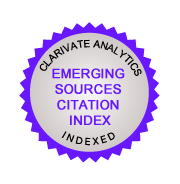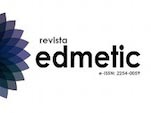Students’ and teachers’ perceptions of a mobile learning intervention in English as Foreign Language
DOI:
https://doi.org/10.24310/innoeduca.2018.v4i1.3024Keywords:
ICT, secondary schoiol, mobile learning, innovationAbstract
Nowadays, the use of mobile technologies is widely extended. As a consequence, over the last few years there has been an increasing interest in including these elements in teaching as well as in highlighting its educational possibilities. However, there is still little research that has studied this aspect in secondary education. Thus, the aim of this study was to know the students’ and teachers’ perceptions of a Mobile Assisted Language Learning intervention. A case study design was used. 18 secondary school students and a teacher participated in the research. Different instruments were used to collect data: (1) teacher’s diary, (2) open-ended question and (c) semi-structured interviews. Atlas.ti 7 software was used to help with data management. All the participants’ answers were analysed via content analysis and constant comparison methods. Data analysis produced six categories: learning, novelty, cooperation, motivation, teaching approach, and friendship. The results showed that the intervention helped students to improve their linguistic competence, their motivation for learning English, to work in teams, and to improve their friendship links with their classmates. Likewise, the approach was considered as novel, far from the traditional approach based on the text book. In conclusion, these results reflect the educational benefits of mobile learning in english as a foreign language in secondary educationDownloads
Metrics
References
Alamer, A. (2015). The Role of EFL Learners’ Motivation in Mobile Language Learning. Comunicación presentada en el First International Conference on Theory and Practice. Adelaida: Australia.
Amador, E., y Pantoja, A. (2017). Eficacia de un programa de intervención basado en el uso de las TIC en tutorías. Revista de Investigación Educativa, 35(1), 215-333. DOI: http://dx.doi.org/10.6018/rie.35.1.248831
Arashnia, M., y Shahrokhi, M. (2016). Mobile Assisted Language Learning: English Pronunciation among Iranian Pre-intermediate EFL Learners. Journal of Applied Linguistics and Language Research, 3(4), 149-162.
Attewell, J. (2005). Mobile technologies and learning: A technology update and m-learning project summary. London, UK: Learning Skills Development Agency.
Bisquerra, R. (coord.) (2012). Metodología de la investigación educativa. Madrid: La Muralla.
Cantillo, C., Roura, M., y Sánchez, A. (2012). Tendencias actuales en el uso de dispositivos móviles en educación. La Educación Digital Magazine, 147, 1-21.
Coll, C. (2013). El currículo escolar en el marco de la nueva ecología del aprendizaje. Aula, 219, 31-36.
Conole, G. (2016). MOOC as disruptive technologies: strategies for enhancing the learner experience and quality of MOOCs. Revista de Educación a Distancia, 50(2), 1-18. DOI: http://dx.doi.org/10.6018/red/50/2
Crook, C. (2000). Motivation and the ecology of collaborative learning. En R. Joiner (Ed.) Rethinking collaboration. Londres: Routledge.
Denzin, N. K., y Lincoln, Y. S. (1994). Handbook of qualitative research. Thousand Oaks, CA: Sage. DOI: http://dx.doi.org/10.4135/9781848607927
Fombona, J., y Pascual, M. A. (2013). Beneficios del m-learning en la Educación Superior. Educatio Siglo XXI, 31(2), 211-234.
García-Peñalvo, F. J., y Seoane, A. M. (2015). Una revisión actualizada del concepto de eLearning. Décimo Aniversario. Teoría de la Educación. Educación y Cultura en la Sociedad de la Información, 16(1), 119-144. DOI: http://dx.doi.org/10.14201/eks2015161119144
Hsu, C., Hwang, G., y Chang., C. (2013). A personalized recommendation-based mobile learning approach to improving the reading performance of EFL students. Computers y Education, 63, 327-336. DOI: http://dx.doi.org/10.1016/j.compedu.2012.12.004
Illanas, A., y Llorens, F. (2011). Los retos Web 2.0 de cara al EEES. En C. Suarez- Guerrero, y F. J. Garcia-Penalvo (Eds.), Universidad y Desarrollo Social de la Web (pp. 13-34): Washington: Editandum.
Jones, M. e Issroff, K. (2007). Motivation and mobile devices: exploring the role of appropriation and coping strategies. Research in Learning Technology, 15(3), 247-258.
Keengwe, J., y Bhargava, M. (2014). Mobile learning and integration of mobile technologies in education. Education and Information Technologies, 19(4), 737-746. DOI: http://dx.doi.org/10.1007/s10639-013-9250-3
Klopfer, E., y Squire, K. (2008). Environmental Detectives: the development of an augmented reality platform for environmental simulations. Educational Technology Research and Development, 56(2), 203-228. DOI: http://dx.doi.org/10.1007/s11423-007-9037-6
Kramsch, C., A’Ness, F., y Lam, E. (2000). Authenticity and authorship in the computer mediated acquisition of L2 literacy. Language Learning y Technology, 4(2), 78–104.
Kukulska-Hulme, A., y Shield, L. (2008). An overview of mobile assisted language learning: From content delivery to supported collaboration and interaction. ReCALL, 20(3), 271-289. DOI: http://dx.doi.org/10.1017/S0958344008000335
Lan, Y., Sung, Y., y Chang, K. (2007). A mobile-device-supported peer-assisted learning system for collaborative early EFL reading, Language Learning and Technology, 11(3), 130-151.
Lee, H., y Lee, J. H. (2013). Implementing glossing in mobile-assisted language learning environments: Directions and outlook. Language Learning & Technology, 17(3), 6–22
Libarkin, J. C., y Kurdziel, J. P. (2002). Research methodologies in science education: the qualitative-quantitative debate. Journal of Geoscience Education, 50(1), 78- 86.
Lincoln, Y. S., y Guba, E. G. (1985). Naturalistic inquiry. Newbury Park, CA: Sage. DOI: http://dx.doi.org/10.1177/1468794107085301
Liu, J., Yu, S., y Ran, M. (2008). Research on the communicative mobile English learning model. En Fifth IEEE international conference on wireless, mobile, and ubiquitous technology in education (pp. 60–64). China: Wuhan.
Lu M. (2008). Effectiveness of vocabulary learning via mobile phone. National Keelung Vocational High School. Journal of Computer Assisted Learning, 24(6), 515–525. DOI: http://dx.doi.org/10.1111/j.1365-2729.2008.00289.x
Monguillot, M., González, C., Guitert, M., y Zurita, C. (2014). Mobile learning: a collaborative experience using QR codes. Revista de Universidad y Sociedad del Conocimiento, 11(1), DOI: http://dx.doi.org/10.7238/rusc.v11i1.1899
Mulatu, M. (2015). Language Learning through Mobile Technologies: An Opportunity for Language Learners and Teachers. Journal of Education and Practice, 6(31), 50-53.
Pastor, A., y Zubillaga, A. (2012). La utilización de las TICs en la actividad académica de los estudiantes universitarios con discapacidad. Revista Complutense de Educación, 23(1), 23-49
Saldaña, J. (2009). The Coding Manual for Qualitative Researchers. Thousand Oaks, CA: Sage.
Saran, M., Cagiltay, K., y Seferoglu, G. (2008). Use of mobile phones in language learning: Developing effective instructional materials. Actas del Fifth IEEE International Conference on Wireless, Mobile, and Ubiquitous Technology in Education. Washington: USA. DOI: http://dx.doi.org/10.1109/WMUTE.2008.49
Shih, Y., y Mills, D. (2007). Setting the New Standard with Mobile Computing in Online Learning. International Review of Research in Open and Distance Learning, 8(2), 1-16. DOI: http://dx.doi.org/10.19173/irrodl.v8i2.361
Villalonga, C., y Marta-Lazo, C. (2015). Modelo de integración educomunicativa de “apps” móviles para la enseñanza y el aprendizaje. Pixel-Bit, 46, 137-153. DOI: http://dx.doi.org/10.12795/pixelbit.2015.i46.09
Downloads
Published
How to Cite
Issue
Section
License
All contents published by Innoeduca. International Journal of Technology and Educational Innovation are subject to Creative Commons Attribution-Nocomercial-NoDerivatives 4.0 International License, whose complete text can be consulted at https://creativecommons.org/licenses/by-nc-nd/4.0/legalcode. Thus, copying, distribution, public communication, derivative works and commercial use of content are permitted as of the aforementioned issue provided that the source and the author of the text are cited.
It is the responsibility of the authors to obtain the necessary permits for images that are subject to copyright.

This work is licensed under a Creative Commons Attribution-NonCommercial-NoDerivatives 4.0 International License.








1.jpg)


242.png)







